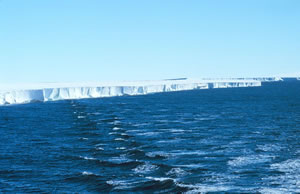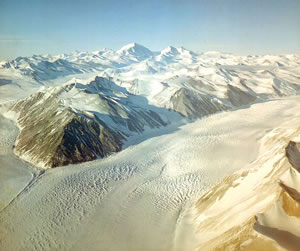The Ross Ice Shelf is the largest body of floating ice in the world.
Named for Captain James Clark Ross, who discovered it in 1841, the Ross Ice Shelf is about 800km (500mi) long and all but fills a huge bay of the Antarctic continent. In the shelf's southern reaches, nearest the True South Pole, the ice can be as thick as 750m (2,400ft). It is about half as thick in the north.
 When seen from afar, the seaward side of the ice shelf appears to be a perfectly straight line. At close quarters, the ice cliffs can be seen to rise as much as 70m (230ft) above sea, creating a blue-green sparkle under the rays of the sun.
When seen from afar, the seaward side of the ice shelf appears to be a perfectly straight line. At close quarters, the ice cliffs can be seen to rise as much as 70m (230ft) above sea, creating a blue-green sparkle under the rays of the sun.
The huge sheet of ice moves toward the sea at a rate between 1.6m (5ft) and 3m (10ft) each day. This constant motion is generated from three sources: glaciers from behind, snow from above and ice from below.
 Several huge glaciers, such as the Beardmore Glacier, flow down from the distant Transantarctic Mountains. They add continuous quantities of ice to the rear of the shelf, nudging it forward. The enormous amounts of snow that fall on the shelf s surface each year are unable to melt because of the cold air.
Several huge glaciers, such as the Beardmore Glacier, flow down from the distant Transantarctic Mountains. They add continuous quantities of ice to the rear of the shelf, nudging it forward. The enormous amounts of snow that fall on the shelf s surface each year are unable to melt because of the cold air.
Layer upon layer of fresh snow builds up until the weight of the upper layers causes the layers below to become compacted into ice. Simultaneously, the freezing sea beneath the shelf pushes upward. These constant additions to its weight cause the lower layer of the shelf to flatten out and move in the only direction possible - to the sea.
Crevasses and fractures in the shelf can run for many miles, often forming inlets of open water. When such a fracture encircles a mass of ice, gigantic blocks break free from the main shelf. Drifting as vast tablelands of ice, such bergs are commonly around 40km (25mi) long.
Many expeditions within Antarctica have used the Ross Ice Shelf as a base camp because it is so flat.